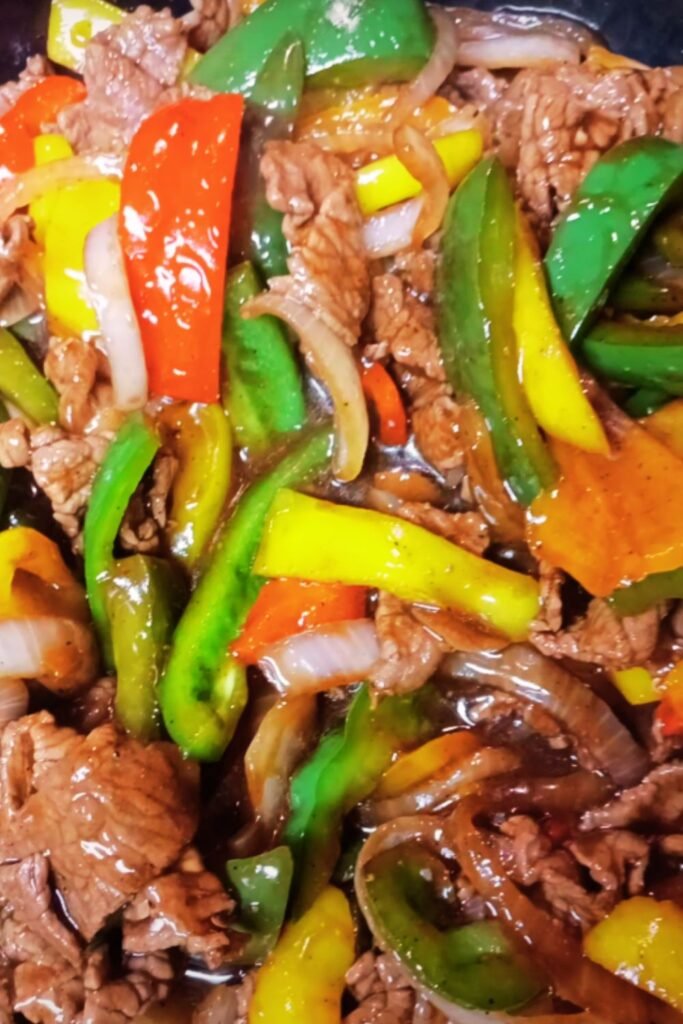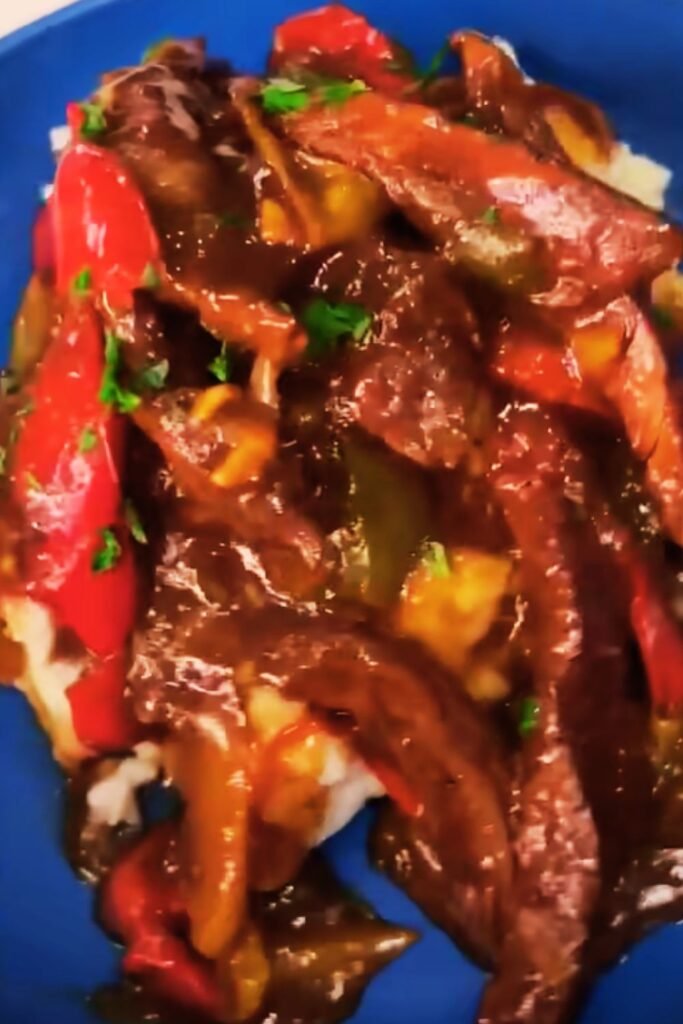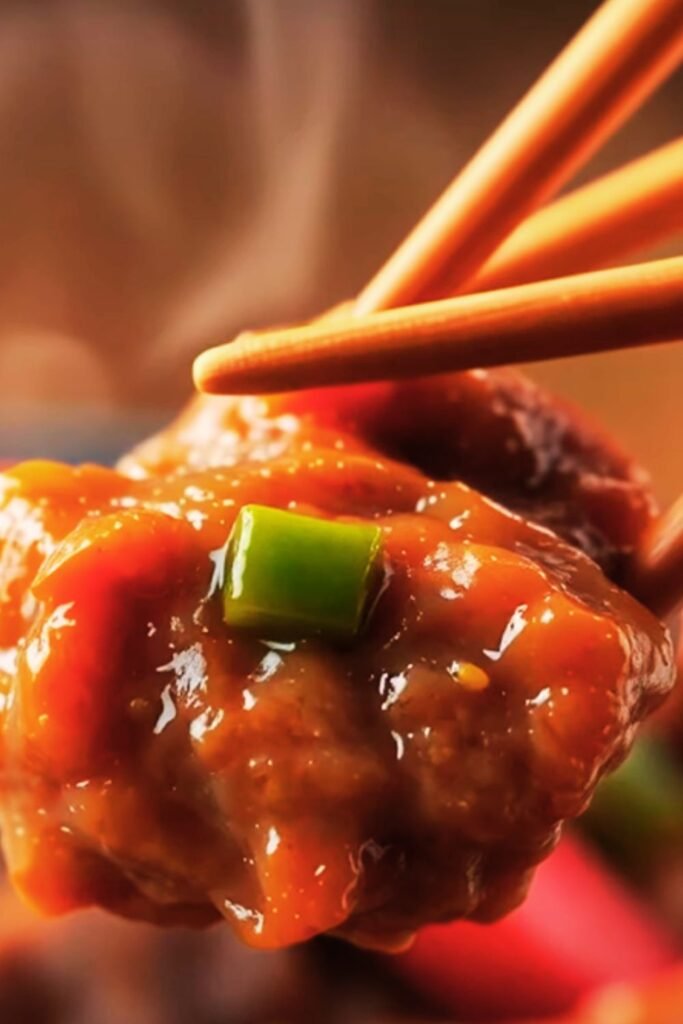I still remember the first time I encountered authentic Chinese pepper steak at my neighborhood’s hole-in-the-wall restaurant. The sizzling platter arrived at my table, steam rising from perfectly tender beef strips nestled among vibrant bell peppers, all glistening with a glossy sauce that made my mouth water instantly. That moment sparked what would become a years-long obsession with recreating this seemingly simple yet incredibly nuanced dish in my own kitchen.
After countless experiments, burnt vegetables, and overly tough beef strips, I’ve finally cracked the code. What started as frustration has evolved into genuine mastery, and now I’m thrilled to share every secret, technique, and hard-earned lesson that transformed my pepper steak from disappointing to absolutely divine.
Chinese pepper steak represents more than just another stir-fry dish – it embodies the fundamental principles that make Chinese cuisine so extraordinary. The interplay between textures, the careful balance of flavors, and the lightning-fast cooking technique all come together to create something that’s simultaneously comforting and exciting. What I find most fascinating is how this dish manages to be both accessible to home cooks yet challenging enough to keep pushing your skills forward.
The beauty lies in its deceptive simplicity. At first glance, you might think it’s just beef and peppers tossed together. However, achieving restaurant-quality results requires understanding the science behind velvet beef, mastering heat control, and developing an intuitive sense for timing that only comes through practice and patience.
Understanding the Fundamentals
Chinese Pepper Steak (青椒牛肉丝): A classic Cantonese stir-fry featuring tender beef strips, colorful bell peppers, and onions united by a savory-sweet sauce that perfectly balances umami, sweetness, and subtle heat.
Wok Hei: The elusive “breath of the wok” – that distinctive smoky flavor and aroma that comes from cooking over intense heat in a properly seasoned wok. This is what separates restaurant-quality dishes from home attempts.
Velveting: A traditional Chinese technique where proteins are marinated in cornstarch and egg white, then briefly blanched or oil-poached to create incredibly tender, silky textures that remain juicy even during high-heat stir-frying.
Mise en Place: The French culinary term that’s absolutely crucial for successful stir-frying – having all ingredients prepped, measured, and ready before you even heat the wok.
Selecting Your Ingredients Like a Pro
My ingredient selection process has evolved dramatically over the years. Initially, I’d grab whatever beef looked decent and any peppers that weren’t obviously past their prime. Now I approach each component with the same care a painter selects their colors.
The Beef Decision
Choosing the right cut makes or breaks this dish. Through extensive testing, I’ve identified three cuts that consistently deliver exceptional results:
Flank Steak: My personal favorite and the cut I recommend most enthusiastically. Its pronounced grain structure allows marinades to penetrate deeply, and when sliced correctly against the grain, it becomes incredibly tender. The robust beef flavor holds its own against the bold sauce without being overwhelmed.
Ribeye: While more expensive, ribeye delivers unmatched tenderness and rich, buttery flavor. It’s particularly forgiving for beginners since it’s naturally tender and harder to overcook. I reserve this cut for special occasions or when I’m cooking for guests who might not appreciate the chewier texture of flank steak.
Sirloin: Offers an excellent middle ground between cost and quality. It’s more tender than flank steak but less expensive than ribeye. The flavor is clean and beefy without being too intense, making it perfect for those who prefer milder tastes.
Pepper Selection Strategy

Not all peppers are created equal, and my approach to selection has become quite methodical:
Red Bell Peppers: These provide natural sweetness and stunning visual appeal. I look for peppers that feel heavy for their size with glossy, unwrinkled skin. The sweetness intensifies when stir-fried quickly over high heat.
Yellow Bell Peppers: Offer mild flavor with beautiful golden color. They’re less sweet than red peppers but contribute a subtle complexity that rounds out the overall flavor profile.
Green Bell Peppers: Bring a slight bitterness that balances the dish’s sweetness. Many recipes skip green peppers, but I find they add essential depth and prevent the dish from becoming cloying.
Orange Bell Peppers: My secret weapon for extra visual impact. They’re sweet like red peppers but with a unique flavor that adds another dimension to the dish.
My Perfected Marinade Formula
Years of experimentation have led me to this precise marinade composition. Each ingredient serves multiple purposes, and I’ve learned that substitutions often compromise the final result.
| Ingredient | Amount | Primary Function | Secondary Benefits |
|---|---|---|---|
| Light Soy Sauce | 2 tablespoons | Base flavor and color | Helps tenderize proteins |
| Cornstarch | 1 tablespoon | Creates protective coating | Adds subtle thickening to sauce |
| Shaoxing Wine | 1 tablespoon | Flavor enhancement | Natural meat tenderizer |
| Sesame Oil | 1 teaspoon | Aromatic depth | Prevents sticking during cooking |
| White Pepper | 1/4 teaspoon | Gentle heat | Complements beef without overwhelming |
| Egg White | 1 large | Protein binding agent | Creates silky texture |
| Minced Ginger | 1 teaspoon | Aromatic complexity | Natural tenderizing enzymes |
The magic happens during the marinating process. I’ve found that 30 minutes produces good results, but allowing the beef to marinate for 2-4 hours creates truly exceptional tenderness. The cornstarch forms a protective barrier that seals in juices, while the egg white creates that characteristic velvety texture that distinguishes Chinese restaurant cooking from typical home stir-fries.
Sauce Composition Mastery
Creating the perfect sauce requires understanding how each component contributes to the final flavor profile. My formula has evolved through countless tastings and adjustments:
| Component | Standard Amount | Flavor Profile | Adjustment Guidelines |
|---|---|---|---|
| Dark Soy Sauce | 1 tablespoon | Deep color, mild saltiness | Increase for darker color |
| Light Soy Sauce | 2 tablespoons | Primary saltiness, umami | Reduce if using salted stock |
| Oyster Sauce | 2 tablespoons | Sweetness, complexity | Premium brands make huge difference |
| Chicken Stock | 1/3 cup | Liquid base, richness | Low-sodium preferred |
| Cornstarch Slurry | 1 tablespoon + 2 tablespoons water | Thickening, gloss | Mix just before using |
| Sugar | 1/2 teaspoon | Balancing sweetness | Adjust based on oyster sauce sweetness |
| Sesame Oil | 1/2 teaspoon | Finishing aroma | Add off heat to preserve flavor |
The key insight I’ve gained is that sauce balance varies depending on your ingredients’ inherent characteristics. Premium oyster sauce contains more natural sweetness, requiring less added sugar. Similarly, if you’re using particularly salty stock, reduce the soy sauce accordingly.
Step-by-Step Cooking Mastery
Preparation Phase Excellence

Success in stir-frying begins long before you heat the wok. My preparation routine has become almost ritualistic:
Beef Preparation: I slice the beef into strips approximately 1/4 inch thick and 2-3 inches long, always cutting against the grain. This size ensures even cooking while maintaining ideal texture. After cutting, I immediately place the beef in the marinade to begin the tenderizing process.
Vegetable Preparation: Consistency in size is crucial for even cooking. I cut all vegetables into similar-sized strips – roughly matching the beef dimensions. Onions get sliced into crescents about 1/4 inch thick, while peppers are cut into strips of similar width.
Aromatics: Garlic gets minced finely, and I prefer grating ginger on a microplane rather than chopping it. This creates a paste-like consistency that distributes more evenly throughout the dish.
Sauce Mixing: I combine all sauce ingredients except the cornstarch slurry in one bowl, then prepare the slurry separately. The slurry gets mixed just before adding to prevent clumping.
Cooking Execution Perfection
The actual cooking happens incredibly quickly, which is why thorough preparation is essential. My technique has been refined through hundreds of attempts:
Heat Management: I preheat my wok over the highest heat setting until it’s smoking. This step is non-negotiable – insufficient heat results in steamed rather than stir-fried ingredients.
Oil Introduction: I add oil and immediately swirl to coat the entire surface. The oil should shimmer and move freely, indicating proper temperature.
Beef Cooking: The marinated beef goes in first, spread in a single layer. I resist the urge to move it immediately, allowing proper searing for 60-90 seconds. Then I stir-fry vigorously for another 60-90 seconds until the beef is about 80% cooked. It gets removed and set aside – it will finish cooking when returned to the wok.
Aromatics and Vegetables: After adding a touch more oil if needed, I add minced garlic and ginger, stir-frying for just 15-20 seconds until fragrant. Onions go in next, cooking for about 1 minute until they begin to soften. Finally, bell peppers are added and stir-fried for 2-3 minutes until crisp-tender.
Final Assembly: The beef returns to the wok, and I give the sauce mixture a final stir before adding it. Everything gets tossed together until the sauce thickens and coats all ingredients evenly – usually 60-90 seconds.
Nutritional Profile and Health Benefits
Understanding the nutritional aspects helps me make informed decisions about portion sizes and complementary dishes:
| Nutrient | Per Serving (1/4 recipe) | Daily Value % | Health Benefits |
|---|---|---|---|
| Calories | 295 | 15% | Moderate calorie density |
| Protein | 32g | 64% | Complete amino acid profile |
| Carbohydrates | 14g | 5% | Primarily from vegetables |
| Dietary Fiber | 4g | 16% | Supports digestive health |
| Total Fat | 15g | 23% | Mostly unsaturated fats |
| Iron | 4.2mg | 23% | Supports oxygen transport |
| Vitamin C | 120mg | 133% | Powerful antioxidant |
| Vitamin B12 | 2.8mcg | 117% | Nervous system support |
| Zinc | 6.1mg | 55% | Immune system function |
The high protein content makes this dish excellent for muscle maintenance and growth, while the abundance of colorful vegetables provides a wide spectrum of antioxidants and phytonutrients. The cooking method preserves most of the vegetables’ nutritional value since they’re cooked quickly over high heat.
Serving Suggestions and Pairings

My approach to serving Chinese pepper steak has evolved to consider both traditional pairings and modern dietary preferences:
Classic Presentations:
- Steamed jasmine rice creates the perfect neutral base
- Brown rice adds nutty flavor and additional fiber
- Fried rice transforms this into a more substantial meal
Modern Alternatives:
- Cauliflower rice for low-carb dieters
- Quinoa provides complete protein and interesting texture
- Rice noodles create a more substantial, unified dish
Complementary Vegetables:
- Steamed broccoli adds color and nutrition
- Stir-fried bok choy provides authentic Chinese restaurant feel
- Simple cucumber salad offers refreshing contrast
Garnish Options:
- Sliced green onions add fresh bite and color
- Toasted sesame seeds provide textural interest
- Fresh cilantro brightens the overall flavor profile
Troubleshooting Common Failures
Through my journey, I’ve encountered and solved virtually every problem that plagues home cooks attempting this dish:
Tough, Chewy Beef: Usually caused by cutting with the grain instead of against it, or overcooking. The solution involves proper knife technique and understanding that beef continues cooking even after removal from heat.
Mushy Vegetables: Results from insufficient heat or overcrowding the wok. Vegetables should maintain some crispness and bright color. Cooking in batches prevents overcrowding issues.
Watery Sauce: Occurs when vegetables release too much moisture or when cornstarch isn’t properly activated. Ensure vegetables are dry before cooking, and make sure the wok is hot enough for the sauce to bubble vigorously.
Lack of Flavor Depth: Often stems from using low-quality condiments or rushing the marinating process. Investing in premium soy sauce and oyster sauce makes a dramatic difference.
Uneven Cooking: Results from inconsistent ingredient sizes or adding everything simultaneously. Uniform cutting and staged cooking solve this issue.
Advanced Techniques for Excellence
As my skills developed, I discovered several advanced techniques that elevate this dish from good to extraordinary:
Wok Seasoning: Properly seasoned carbon steel woks develop natural non-stick properties and impart unique flavors impossible to achieve with other cookware. Regular use and proper maintenance create better results over time.
Temperature Layering: Different ingredients require different cooking temperatures. I’ve learned to adjust heat throughout the cooking process rather than maintaining constant high heat.
Sauce Timing: Adding sauce at the optimal moment – when vegetables are perfectly crisp-tender – ensures proper thickening without overcooking the vegetables.
Resting Technique: Allowing the finished dish to rest for 60 seconds before serving lets flavors meld and sauce consistency stabilize.
Variations and Creative Adaptations
My experimentation has led to several successful variations that maintain the dish’s essential character while offering different experiences:
Protein Alternatives:
- Chicken breast or thighs work excellently with the same marinade
- Firm tofu creates satisfying vegetarian versions
- Shrimp cooks even faster and offers delicate flavor
Spice Variations:
- Fresh chilies add authentic heat
- Szechuan peppercorns provide unique numbing sensation
- Black pepper creates different flavor profile than white pepper
Regional Adaptations:
- Cantonese style emphasizes subtlety and ingredient purity
- Szechuan version incorporates doubanjiang for deeper, more complex flavors
- American-Chinese adaptations often include additional sweetness
Storage and Reheating Wisdom
Proper storage techniques preserve quality and extend the dish’s life:
Refrigeration Guidelines: Store in airtight containers for up to 3 days. The sauce may thicken when cold, which is completely normal.
Freezing Considerations: While possible, freezing significantly affects vegetable texture. If you must freeze, consume within 1 month and expect softer vegetables.
Reheating Methods: Stovetop reheating in a hot wok or skillet produces the best results. Add a splash of stock or water if the sauce seems too thick. Microwave reheating works but may result in uneven heating and compromised texture.
Questions and Answers
Q: What’s the biggest mistake home cooks make with Chinese pepper steak? The most common error I see is using insufficient heat. Many home cooks are afraid of high temperatures, but proper stir-frying requires intense heat to achieve that characteristic wok hei flavor and maintain vegetable crispness. Your wok should be smoking hot before you add any ingredients.
Q: Can I substitute the beef with other proteins? Absolutely! Chicken thighs work wonderfully and are actually more forgiving than beef since they’re naturally more tender. Firm tofu creates an excellent vegetarian version – just press out excess water first. Shrimp cooks even faster than beef, so reduce the cooking time accordingly.
Q: How important is it to use a wok versus a regular skillet? While a wok is ideal, a large, heavy-bottomed skillet can produce excellent results. The key is having enough surface area to avoid overcrowding and the ability to maintain high heat. Carbon steel woks are my preference, but well-seasoned cast iron skillets work too.
Q: My sauce never seems to thicken properly. What am I doing wrong? The most likely culprit is not stirring the cornstarch slurry immediately before adding it – cornstarch settles quickly. Also, ensure your wok is hot enough for the sauce to bubble vigorously. The cornstarch needs that bubbling action to activate and thicken properly.
Q: How do I know when the beef is perfectly cooked? The beef should be lightly browned on the outside but still slightly pink inside when you first remove it from the wok. Remember, it will continue cooking when you add it back with the sauce. Total cooking time should be 3-4 minutes maximum to maintain tenderness.
Q: Can I prepare components ahead of time? Yes, and I actually recommend it! You can marinate the beef and prep all vegetables up to 4 hours in advance. Store everything separately in the refrigerator. Mix the sauce just before cooking to prevent separation. The actual stir-frying must be done immediately before serving for optimal texture.
Q: What’s the secret to getting that glossy, restaurant-style sauce? The gloss comes from properly activated cornstarch and the addition of sesame oil at the very end. Make sure your sauce bubbles vigorously for at least 30 seconds to fully activate the cornstarch, then remove from heat and add sesame oil for that beautiful shine.
Q: How can I make this dish less salty? Use low-sodium soy sauce and reduce the amount by about 25%. You can substitute some soy sauce with rice vinegar or a splash of lemon juice for acidity. Adding more ginger and garlic also helps maintain flavor complexity while reducing sodium content.
This comprehensive guide represents my years-long journey from pepper steak disasters to consistent triumphs. The beauty of this dish lies not just in its delicious flavors, but in how it teaches fundamental stir-frying techniques that apply to countless other Chinese dishes. Every time I make it, I’m reminded why I fell in love with Chinese cooking in the first place – the perfect balance of technique, timing, and taste that creates something truly magical from simple ingredients.